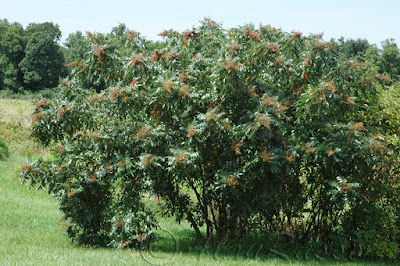I have two large "Winged" Sumac on my property. One I planted myself from a plant that started growing right next to my propane tank. I let them grow because I love the way Sumac looks in the Fall with the red berries and the red leaves, not to mention how useful they are. Plus, that one plant hides my ugly propane tank! Most people consider them weeds and have no problem poisoning their homes and our water supply to get rid of them.
I have written on making Sumac Aide before, http://ethnobotanist128.blogspot.com/2011/09/sumac-aide.html so I am not going to go into detail on making Sumac Aide again, so check out the previous post if you have never made it before. This is just a reminder to get out there and collect your berries before all the good stuff is washed away by a late summer rain!
 |
| Winged Sumac Drupes |
 |
| The "Wings" |
 |
| Berries covered in Malic Acid |
 |
| Soaking the Berries to dissolve the Malic Acid |
 |
| Sumac Aide! |
Other types of Sumac make a much redder drink than my Sumac does. If you use Staghorn Sumac Berries, be sure to strain out the tiny hairs through a tea strainer or they may irritate your throat. For those who are thinking about all the other stuff that might be in your drink, insects, bacteria etc., once you have your drink made you can now boil it to kill anything if you like. I just drink it as is most of the time but I boiled it this time so I could seal it in Mason Jars to keep it longer. Also heating it and drinking it as a tea with a little Honey is delicious!
As always, be sure to identify your plants correctly. There are many plants in the Fall that have red berries so be careful. Also, Sumac is very common along roadside transition zones and in drainage ditches, stay far away from these toxic environments when you collect.
Peace

Excellent post, however, you really should link that recipe for sumacade. People tend to be lazy bollocks these days. Cheers for the excellent share. I love reading your posts and am not a lazy bollocks so have that recipe stashed away for when our sumac is ready :)
ReplyDeleteLazy bollocks? There is a phrase I have never heard before!
DeleteJust looked at your Blog, glad to see you have written a post, though it still blows me away that you are talking about Spring when it is the end of Summer here! The internet sure has made the world a lot smaller.
Write more about the plants of Australia!
Peace